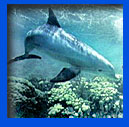The
Rock Iguana

The
Turks and Caicos
Rock Iguana, a harmless reptile, is found
nowhere else in the world. Over 50, 000 are scattered across the
islands and cays. If you want to learn more about this fascinating
creature, visit the Rock Iguana Page.
The
JoJo
Dolphin
Project

Perhaps
the most beloved individual in the Islands is "JoJo" -
a wild Atlantic bottlenosed dolphin that frequently befriends
swimmers and divers.
Her ease among humans has prompted a major scientific study
and qualified her as a national treasure.
The islands are arrayed around the edges of two large limestone plateaus, the Turks Bank, with deep offshore waters that serve as major transit points for Humpback Whales, spotted Eagle rays, Manta Rays and Turtles. These same rich waters are used by anglers who are fishing for Tuna, Wahoo and Blue Marlin. Bordering the edges of the islands are lines of coral reef and some of the most impressive walls of coral in the Caribbean.
 In
the last decade on Turks and Caicos, divers have begun to discover
some of the
finest coral reefs and walls in the world. From the
legendary walls of Grand Turk, West Caicos and Provo's
Northwest Point to the historic wrecks south of Salt Cay,
a dozen world class walls have become Mecca for the
serious diver.
In
the last decade on Turks and Caicos, divers have begun to discover
some of the
finest coral reefs and walls in the world. From the
legendary walls of Grand Turk, West Caicos and Provo's
Northwest Point to the historic wrecks south of Salt Cay,
a dozen world class walls have become Mecca for the
serious diver.
From late December through April, the entire Atlantic herd of 2,500 Humpback Whales pass through the shores on their annual migration to the Mouchoir Bank, just 20 - 30 miles southeast. During this period divers can listen to an underwater concert of the wale's' songs. During the summer, divers encounter Manta Rays cruising the face of the walls. Encounters with Dolphin are not uncommon.
The
salt ponds and inland marshes serve as excellent feeding
grounds for resident and migratory birds. Search for
Great Blue Herons, Flamingos, osprey and Pelicans
alongside Egrets, Terns, Frigates, Boobies and other
water birds. As part of the National Parks system more
than twelve small cays have been set aside and protected
for breeding grounds.
On some of the less disturbed and smaller islands such as Little Water Cay or Great Sand Cay, it is the Turks island Iguana that dominates the land. The Iguana is endangered and delicate but it thrives on these deserted islands, away from the influence of man. These islands are also protected by the National Parks system.
The
National Parks were designed to protect the scenic
environment and habitats, both to preserve and conserve
them for future generations as well as make them
available for public recreation.

In
1992 the government set aside 33 specific protected
areas, a list that include nature reserves, sanctuaries
and historical sites totaling more than 325 square miles.
210 square miles of this total amount are sensitive and
ecologically essential wetlands ratified under the
international Ramsar Bureau. Other protected areas
include marine replenishment areas as well as breeding
grounds for turtles, seabirds and other creatures. A
marine mooring buoy system is just one of the many
projects currently underway.
| Home | History | People See & Do | Places | The Wild Tours | Essentials | Accommodation | Email Us |
| The Original Official Web Site of the Turks & Caicos Tourist Board | ||
| This page, and all contents
of this Web site are Copyright (c) 1997-2006 by interKnowledge Corp.. All rights reserved. |
||